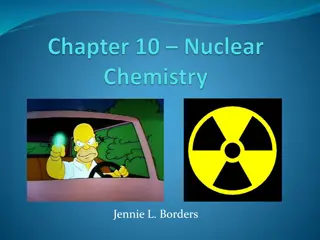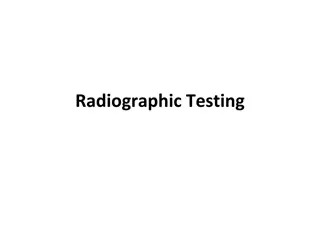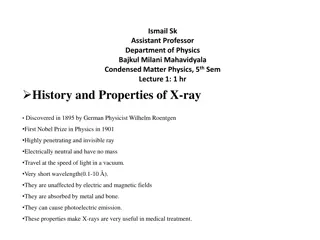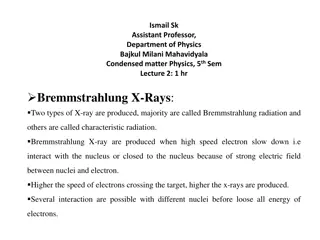X-Rays and Their Production
X-rays are high-energy electromagnetic rays commonly produced by accelerating electrons onto a target material, such as tungsten. Increasing tube voltage and current affect the quality and intensity of X-rays. Despite their efficiency issues, X-rays are highly penetrative and useful in medical imaging to detect bone fractures and other conditions.
Download Presentation

Please find below an Image/Link to download the presentation.
The content on the website is provided AS IS for your information and personal use only. It may not be sold, licensed, or shared on other websites without obtaining consent from the author.If you encounter any issues during the download, it is possible that the publisher has removed the file from their server.
You are allowed to download the files provided on this website for personal or commercial use, subject to the condition that they are used lawfully. All files are the property of their respective owners.
The content on the website is provided AS IS for your information and personal use only. It may not be sold, licensed, or shared on other websites without obtaining consent from the author.
E N D
Presentation Transcript
X-rays are commonly produced by accelerating electrons through a potential difference (a voltage drop) and directing them onto a target material. (The metal tungsten is a typical example). The incoming electrons release X-rays as they slow down in the target. The x-ray photons produced in this manner range in energy from near zero up to the energy of the electrons.
Increasing the tube voltage (EHT) Increasing the high p.d. that is used to accelerate the electrons will give the average electron more energy when it hits the target. The quality or penetrating power increases
Increasing the tube current Increases the rate of thermionic emission - more electrons of same energy hit the target - more X-rays produced. The intensity increases.
EFFICIENCY Most of the kinetic energy is converted into heat. Generally, more than 99% of the kinetic energy of projectile electrons is converted to thermal energy, leaving less than 1% available for the production of X-radiation. In this sense, the X-ray machine is a very inefficient apparatus.
X-Rays are: High frequency, high energy electromagnetic rays. Undetectable by the human senses Very penetrating Cause low localized ionization. Generated when high energy electrons strike a metal target
Quality of X-Rays The penetrating power of an X-ray beam X-rays with high penetrability are termed high-quality or hard X-rays, and those with low penetrability are of low quality and are called soft X-rays. As the energy of an X-ray beam is increased, the penetrability or quality of the X-ray beam is also increased. Hard x-rays - highly penetrating x-rays Soft x-rays - low penetrating x-rays
Properties of X-Rays X-rays can pass easily through flesh but not through bone. X-ray photographs are used to show the image of bones against a black background. These photographs can show if bones are broken or damaged.
How do X-rays cause Harm? Low intensity X-rays can damage living cells and cause cancer. People who work with X-rays take measures to protect themselves from exposure. They wear a film badge and stand behind special screens when the X-ray machine is switched on. High intensity X-rays will kill living cells.
Uses of X-Rays: Imaging for detection of broken bones or tumours: simple X-ray, CT scanning, barium meal scanning. High energy ones for treatment of cancer (destroying cells)























